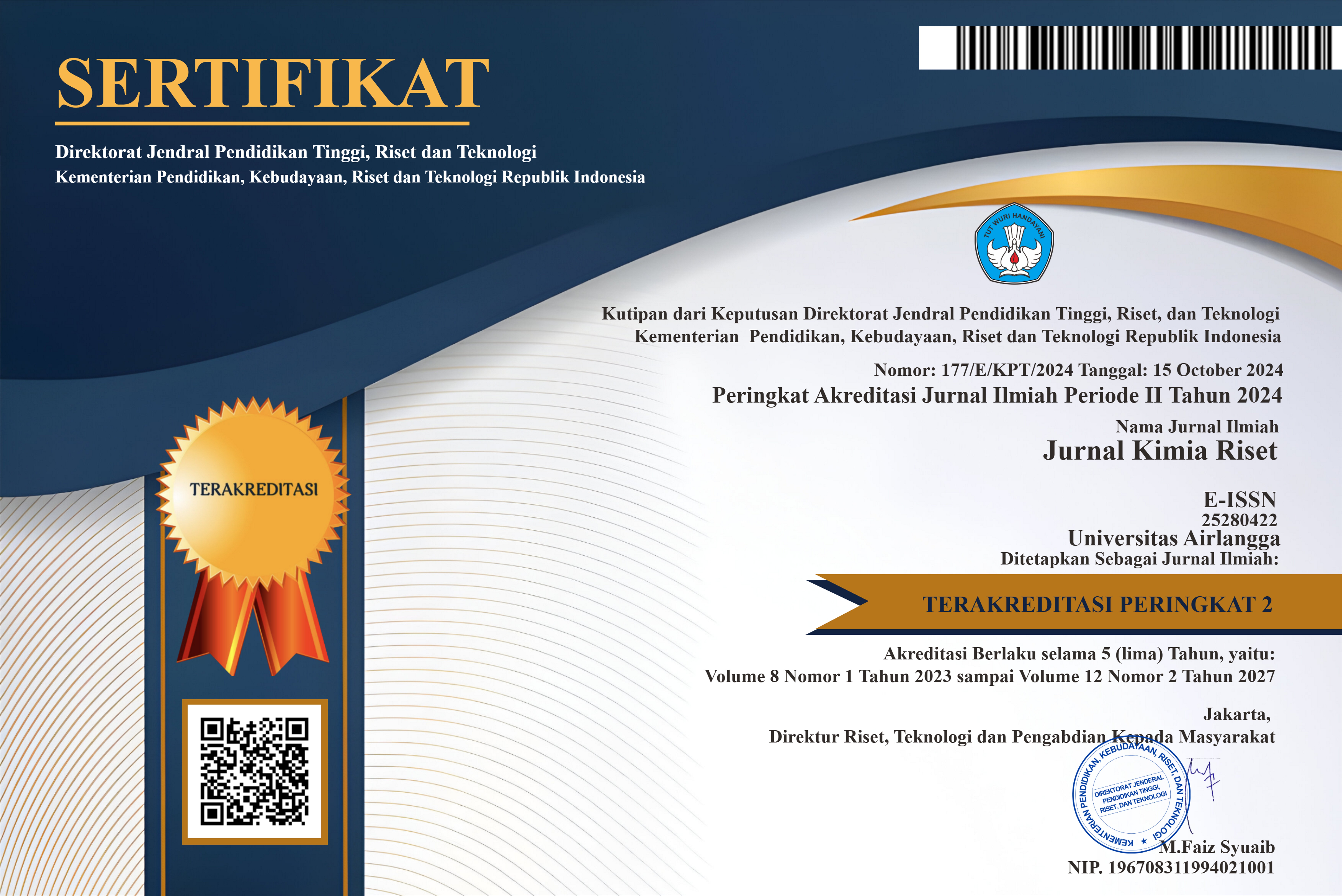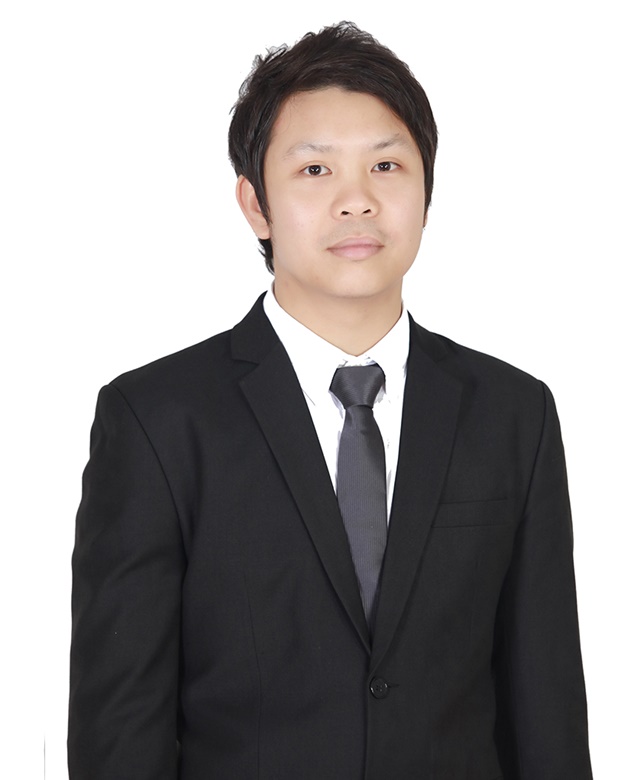Pengaruh Variasi Konsentrasi Urea Terhadap Fotoaktivitas Material Fotokatalis N/TiO2 Untuk Penjernihan Limbah Batik Tenun Ikat Kediri
Downloads
ABSTRAK
Fotokatalis merupakan suatu proses transformasi senyawa kimia yang dibantu oleh adanya material katalis dan cahaya. Teknologi fotokatalis sering digunakan untuk mengolah air polutan maupun limbah tekstil. Industri tenun ikat di Bandar Kidul, Kediri menggunakan pewarna sintesis sehingga menghasilkan limbah pewarna yang dapat mencemari lingkungan. Pada penelitian ini telah disintesis N/TiO2 menggunakan metode wet impregnation (impregnasi basah) untuk menjernihkan limbah batik tenun Kediri. Sintesis dilakukan dengan mereaksikan TiO2 yang dilarutkan ke dalam Aqua DM dan urea dengan variasi konsentrasi 1;2;3;4;5 %(b/b)(N/Ti). Berdasarkan hasil karakterisasi diketahui bahwa semakin besar konsentrasi urea yang ditambahkan, material N/TiO2 yang dihasilkan memiliki ukuran kristal dan band gap(Eg) yang semakin kecil. Selain itu, permukaan yang dihasilkan pada N/TiO2 5% lebih teratur atau homogen apabila dibandingkan dengan TiO2 undoped.. Berdasarkan hasil uji aktifitas fotokatalis N/TiO2 terhadap limbah batik tenun diketahui bahwa material katalis dengan hasil limbah paling jernih adalah material dengan konsentrasi urea paling besar, yaitu N/TiO2 5%. Hal ini menunjukkan bahwa semakin besar konsentrasi yang ditambahkan maka fotoaktivitas yang dihasilkan akan semakin besar
Kata Kunci: Fotokatalis;TiO2;N/TiO2; Limbah batik tenun ikat.
ABSTRACT
Photocatalyst is a process transformation of chemical compounds under UV irradiation in the presence of catalyst material. Photocatalyst technology is often used to treat pollutant water or textile waste. Tenun ikat industry in Bandar Kidul Kediri uses synthetic dyes so it produce dye waste which can pollute the environment. The effect of variations of concentration of urea on synthesis of N/TiO2 material by wet impregnation in order to purify the batik weaving waste in Kediri had been studied. The synthesis of N/TiO2 was done by mixing TiO2 in aqua DM and urea with the variation of concentration 1,2,3,4 and 5% (w/w) (N/Ti). Based on the characterization results, it is known that the more concentration of urea added, the N/TiO2 material has a smaller crystal size and a smaller band gap (Eg). In addition, the surface produced at N/TiO2 5% is more even or homogeneous when compared to undoped TiO2. Based on the results of the N/TiO2 photocatalyst activity test on woven batik waste, it is known that the catalyst material with the clearest waste results is the material with the highest urea concentration, which is N/TiO2 5%. This shows that the more concentration added the greater the photoactivity produced.
Key words: Photocatalyst;TiO2; N/TiO2; woven batik waste.
Abazović, Nadica D., Luciana Mirenghi, Ivana A. Janković, NataÅ¡a Bibić, Daniela V. Å ojić, Biljana F. Abramović, and Mirjana I. ÄŒomor. 2009. "Synthesis and Characterization of Rutile TiO2 Nanopowders Doped with Iron Ions.” Nanoscale Research Letters 4(6):518–25.
Agustina, Tuty Emilia, Ahmad Bustomi, and Jantan Manalaoon. 2016. "Pengaruh Konsentrasi TiO2 Dan Konsentrasi Limbah Pada Proses Pengolahan Limbah Pewarna Sintetik Procion Red Dengan Metode UV/Fenton/TiO2.” Jurnal Teknik Kimia 22(1):65–72.
Araoyinbo, Alaba Oladeji, Moch Mustafa Al Bakri Abdullah, Mohd Arif Anuar Mohd Salleh, Nurul Nadia Abdul Aziz, and Azwan Iskandar Azmi. 2018. "Phase Study of Titanium Dioxide Nanoparticle Prepared via Sol-Gel Process.” in IOP Conference Series.
Condro, Novita, Bing Bedjo T, and Baskoro Banindro. 2014. "Perancangan Buku Tenun Ikat Bandar Kidul Kediri.” Jurnal DKV Adiwarna 6.
Garcia, Christian G., André S. Polo, and Neyde Y. Murakami Iha. 2003. "Photoelectrochemical Solar Cell Using Extract of Eugenia Jambolana Lam as a Natural Sensitizer.” Anais Da Academia Brasileira de Ciencias 75(2):163–65.
Hoffman, Michael R., Scot T. Martin, Wonyong Choi, and W. Bahnemann. 2013. "Environmental Applications of Photocatalysis.” Chemical Reviews 71:35–66.
Hu, Lanying, Hongwei Song, Guohui Pan, Bin Yan, Ruifei Qin, Qilin Dai, Libo Fan, Suwen Li, and Xue Bai. 2007. "Photoluminescence Properties of Samarium-Doped TiO2 Semiconductor Nanocrystalline Powders.” Journal of Luminescence 127(2):371–76.
Irie, Hiroshi, Yuka Watanabe, and Kazuhito Hashimoto. 2003. "Nitrogen-Concentration Dependence on Photocatalytic Activity of TiO 2 - x N x Powders.” J.Phys.Chem 5483–86.
Kusumawardani, Cahyorini. 2009. "Titanium Dioksida Terdoping Nitrogen : Kajian Tentang Sintesis , Karakteristik Dan Aplikasinya.” Pp. 124–33 in Prosiding Seminar Nasional Penelitian, Pendidikan dan Penerapan MIPA, Fakultas MIPA, Universitas Negeri Yogyakarta.
Pinna, Francesco. 1998. "Supported Metal Catalysts Preparation.” Catalysis Today 41(1–3):129–37.
Poluakan, Michelle, Audy Wuntu, and Meiske S. Sangi. 2015. "Aktivitas Fotokatalitik TiO2 – Karbon Aktif Dan TiO2 – Zeolit Pada Fotodegradasi Zat Warna Remazol Yellow.” Jurnal MIPA 4(2):137.
Prastiwi, Berlina Rosa. 2017. "Analisis Dampak Material Batik Cap Terhadap Lingkungan (Studi Kasus : Batik Supriyarso Kampung Batik Laweyan).” Universitas Muhammadiyah Surakarta.
Rosanti, Aulia Dewi. 2014. "Pengaruh Variasi Konsentrasi Garam FeCl3.6H2O,Suhu Kalsinasi, Dan PH Terhadap Karakter Fe-TiO2 Yang Disintesis Menggunakan Metode Sol-Gel.” Universitas Gadjah Mada.
Sari, Nur Meita. 2014. "Tenun Ikat ATBM Di Home Industry Kurniawan Bandar Kidul Kediri Jawa Timur.” Universitas Negeri Yogyakarta.
Sitanggang, Petra Yohana. 2017. "Pengolahan Limbah Tekstil Dan Batik Di Indonesia.” Jurnal Teknik Lingkungan 1(12):1–10.
So, C. M., M. Y. Cheng, J. C. Yu, and P. K. Wong. 2002. "Degradation of Azo Dye Procion Red MX-5B by Photocatalytic Oxidation.” Chemosphere 46(6):905–12.
Tussa'adah, R. dan Astuti. 2015. "Sintesis Material Fotokatalis TiO2 Untuk Penjernihan Limbah Tekstil.” Jurnal Fisika Unand 4(1):91–96.
Wardhani, Sri, Akhmad Bahari, and M. Misbah Khunur. 2016. "Aktivitas Fotokatalitik Beads TiO2-N/Zeolit-Kitosan Pada Fotodegradasi Metilen Biru (Kajian Pengembanan, Sumber Sinar Dan Lama Penyinaran).” Journal of Enviromental Engineering and Sustainable Technology 3(2):78–84.
Zaleska, Adriana. 2008. "Doped-TiO2: A Review.” Recent Patents on Engineering 2(3):157–64.
COPYRIGHT NOTICE
1. By submitting the article to Jurnal Kimia Riset (JKR), the author has agreed to transfer some of the copyrights to the publisher of the research chemistry journal, Universitas Airlangga, indicated in the Copyright Transfer Agreement.
2. Authors still retain significant rights to use and share their own published articles for non-commercial purposes subject to Creative Commons Attribution-NonComercial 4.0 International License
3. All publications (printed/electronic) are open access for educational purposes, research, library, and other non-commercial purposes. Besides the purposes mentioned above, the editorial board is not responsible for copyright violations.















